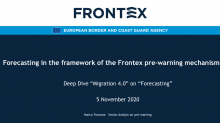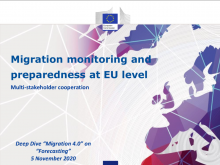Eventos
Deep Dive “Migration 4.0” on “Forecasting”

Invitation-only event is part of a series organized by the German Presidency of the Council of the European Union.
Summary
On 5 November 2020, the International Organization for Migration’s Global Migration Data Analysis Centre (GMDAC) facilitated a Deep Dive seminar ‘The Benefits of Migration Forecasting Tools” as part of the #migration4.0 series organized by the German Presidency of the Council of the European Union. Julia Lendorfer (IOM/ EMN), Marco Fontana (Frontex) and Zsuzsanna Felkai-Janssen (European Commission) presented their work followed by a discussion with delegates from EU Member States and EU agencies. In this post, we will briefly highlight the main results of the seminar:
Julia Lendorfer (European Migration Network) presented the results from an EMN ad-hoc query for EU Member States regarding their current forecasting tools and key lessons from the recent EMN annual conference in Vienna on forecasting:
- Out of 22 responses from EU Member States, 12 reported making use of forecasting methods.
- Most approaches focus on ‘early warning and risk analysis’
- Most Member States use a variety of data sources, yet the most common are administrative data sources and ‘open source data’
- The time horizon – the length of time for which events or outcomes in the future are forecast – is 1-2 years in most cases
- Discussions at the EMN annual conference in September 2019 revealed the complicated relationship between policymakers and analysts. Policymakers need analysts to build models and analysts need policymakers to make their models more relevant. The communication between the two fields is often difficult due to different professional languages.
- A key threat to forecasting models are so-called “black swans” (i.e. events that have a low probability of occurring but have a high impact on migration). However, what is often forgotten is that there are also “grey rhinos” (i.e. known risks that are predictable but that decision-makers choose not to act on).
Marco Fontana (Frontex) described Frontex’ forecasting infrastructure and presented current efforts to pilot a new, more sophisticated forecasting approach to enhance analytical capacity and to support operational planning and deployment:
- The new forecasting approach is being developed to allow Frontex to
- predict ‘irregular border crossings’ dependent on different scenarios and changes in context factors
- consider qualitative insights from experts
- make predictions more accurate and reliable
- assess new migration routes
- extend the analysis network
- The new tool aims to classify change in migration as stable increases, increases and critical increases
- Key challenges for the tool include the difficulty of obtaining data and customizing the tool to be able to answer the right question in the right moment with a high level of accuracy.
Zsuzsanna Felkai-Janssen (European Commission) reported on current results from the EC feasibility study on a EU forecasting tool:
- The tool will build on past and current systems including the EU Integrated Political Crisis Response (IPCR) web platform and the Integrated Situational Awareness and Analysis (ISAA)
- The need for a new tool is described in the new EU Pact on Migration. The “effectiveness of response can be improved through preparation and foresight” and “help move from a reactive mode to one based on readiness and anticipation”.
- The feasibility study focusses on the use of artificial intelligence (AI) to improve the forecasting of irregular migratory movements at the external EU borders in the short term (1-4 weeks) and the medium-term (1-3 months).
- 39 data sources have been deemed as particularly relevant. However, data fragmentation across agencies, data quality and inconsistent data reporting intervals are key challenges.
- Beyond technical challenges related to the data and models, the study identifies a need to build capacity among end-users of any tool.
- Furthermore, a new tool would need a new legislative, financial and political “home” within the EU policy space.
- There is agreement that any system requires human oversight to be guaranteed, and no fully automated decision-making will take place
- Remaining open questions include who would host the tool, which stakeholders would be part of it, how would the tool complement existing efforts, and who would “own” the information produced by the tool.
Overall, the comprehensive and, at times, technical discussion shows that EU stakeholders have moved from debating the need for a tool to the actual “doing”. The apparent challenges and implementation difficulties should not distract from the fact that the discourse on forecasting has advanced considerably and that the awareness and knowledge regarding forecasting approaches have matured extensively. The seminar further contributed to continued coordination and exchange among EU stakeholders around the issue of forecasting and sustained the common goal of working towards practical solutions.
Aim
We would like to take a ”deep dive” and learn more about the benefits of current forecasting systems in the EU. Which forecasting tools are being used, how do they inform policy decisions and what should a future EU-wide forecasting tool a look like?
Speakers
Zsuzsanna Felkai Janssen
Head of Sector for Migration and DG Coordinator for Artificial Intelligence
European Commission
Marco Fontana
Senior Pre-Warning Analyst
Frontex
Julia Lendorfer
Head of Research and Migration Law
IOM Austria/ European Migration Network



